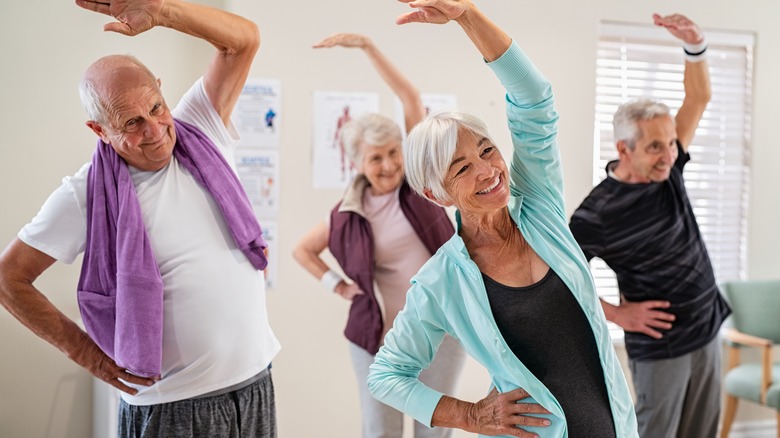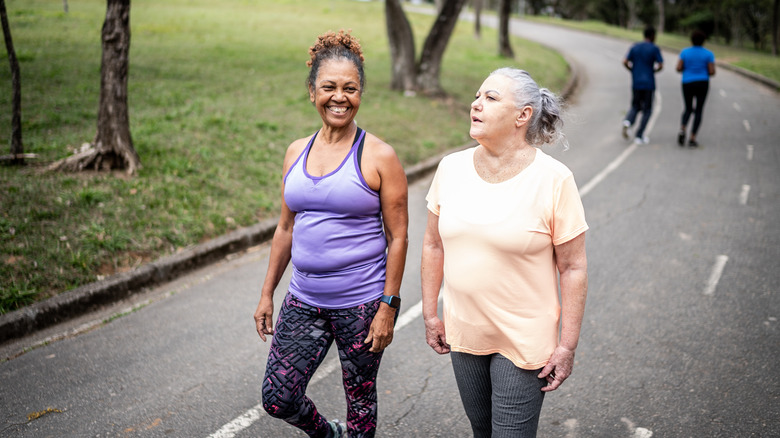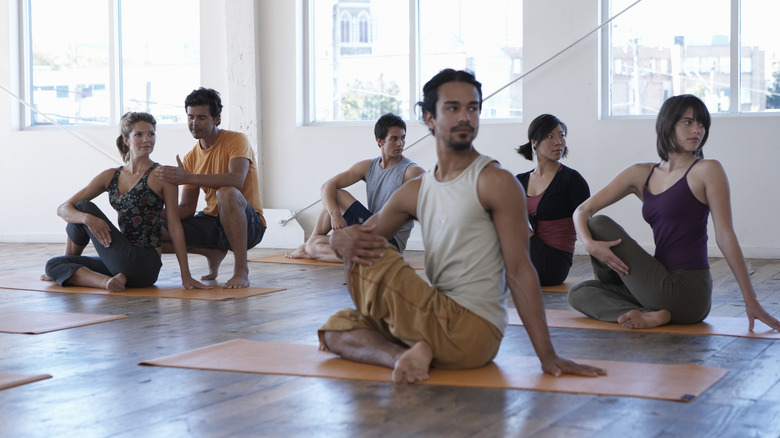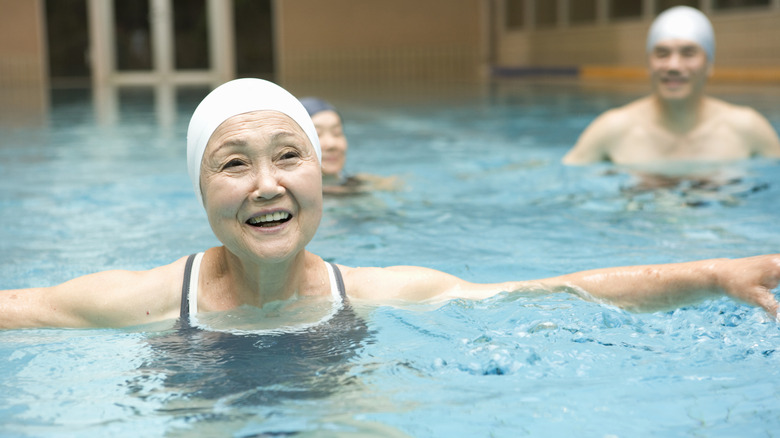The Best Low-Impact Exercises For Lowering High Cholesterol
During your most recent physical, your provider may have noticed that your cholesterol levels were slightly higher than usual. And, if you don't want to get on medication, your doctor may have suggested lifestyle changes like diet and exercise. But, what type of exercise should you choose? If you're new to exercise or you've had issues with your joints, you may be curious to learn about a few low-impact exercises that can take your numbers in the right direction. Before you look at exercises, however, it's vital to understand what cholesterol is and why it's so important to get it down.
According to the American Heart Association (AHA), cholesterol is a waxy substance your body uses for building cells and producing vitamins and hormones. While cholesterol gets a bad rap, it's not inherently bad for your body. Cholesterol comes in two types: low-density lipoprotein (LDL) and high-density lipoprotein (HDL). LDL cholesterol numbers should be under 100 mg/dL (milligrams per deciliter) since it's the bad cholesterol that builds up in the arteries. HDL is the good cholesterol that helps protect your body from heart attack and stroke. Your goal for HDL is 60 mg/dL and above. Triglycerides are a type of fat that stores excess energy from the foods you eat; however, they contribute to lining the arteries when they are too abundant. Look to keep your triglycerides below 150 mg/dL.
Now that you know why it's so important to get your cholesterol numbers under control, we'll delve into a few low-impact exercises you might want to try, including walking, skating, cycling, yoga, and swimming. Let's learn about each and discuss how you might incorporate them into your day.
Take a walk for your cholesterol
Getting the news that you need to lower your cholesterol doesn't mean you need to start hitting the gym unless you want to. According to science, taking a walk is an effective way to help those numbers go down. Research published in 2013 in Arteriosclerosis, Thrombosis and Vascular Biology showed that walking was as good for your heart as running. The study examined the effects of moderate walking and vigorous running completed by participants. Surprisingly, those who took a moderate walk for the six-year study showed similar reductions in hypercholesterolemia and hypertension.
Similarly, a 2013 study in The International Journal of Clinical Practice showed that long-term, home-based physical activity helped lower cholesterol. Within the study, patients took a one-hour walk five days a week. After 24 weeks, the participants saw a reduction in their total cholesterol and triglycerides. There was also an increase in HDL cholesterol.
Choosing to incorporate a walk into your life is up to you, but the Centers for Disease Control and Prevention recommend adding 150 minutes of physical activity every week. In addition to hitting the treadmill, try walking on a nature trail or adding a bit of jazzercise to your walking. Make sure it's fun by listening to music or bringing a buddy.
Strap on a pair of skates
You might not have roller skated or rollerbladed since your youth, but skating is a heart-healthy and fun exercise. It is a low-impact exercise that uses varying energy levels to glide along the rink.
According to the AHA, roller skating has the same exact metabolic cost as walking at 4 mph or biking at 10 mph. So, it's considered an aerobic exercise, which will get your heart pumping and help to lower your cholesterol.
While skating mainly focuses on your legs, skate artist Arnav "Sonic" Shah told Health, "You're using your arms and shoulders, but also your abs and back to keep balanced. It uses your whole body in a lot of ways." Since it's low impact, it can alos benefit those with arthritis or movement issues.
Skating takes a pair of skates and a smooth surface. You can lace up and hit a roller skating rink to get a few hours of cardio while listening to your favorite tunes. Skating down a rail trail or even at a skating park is also fun. Just make sure to pad up before you hit the pavement.
Add cycling to your day
Many exercises, even low-impact ones, can be challenging for those with knee problems. Cycling is the perfect solution. This aerobic activity works to get the heart pumping and makes individuals breathe deeper. A 2016 study in the Journal of the American Heart Association found that bicycling to work for a decade improved obesity, hypertension, and cholesterol in Swedish middle-aged men and women. The study also revealed that those who bike to work have a lower risk of developing high cholesterol than those who are sedentary.
A 2016 study in Circulation demonstrated that cycling in 50- to 65-year-olds could also lower their risk of heart attack. The study followed Danish men and women for 20 years. Within 20 years, those who cycled had fewer heart attacks. It concluded that cycling for transportation and leisure benefitted the heart by lowering the risk of heart disease.
Adding cycling to your life isn't hard. Rather than driving to the store, choose to grab your bike. You can also take your bike down a local rail trail to enjoy the beauty of nature. When leaving the house isn't in the cards, add a stationary bike to your workout room to get some cardio in while watching your favorite Netflix addiction.
Engage in yoga for lower cholesterol numbers
You've probably heard the term "yoga" thrown around in the exercise circles. But to get an understanding of how yoga can help you improve your health, it's important to look at what yoga is. The National Center for Complementary and Integrative Health said that yoga, which is rooted in Indian philosophy, is a spiritual movement practice that uses postures, breathing, and meditation to improve your physical and mental health. It's gentle enough that every fitness level can do it.
Research in 2019 in the International Journal of Preventative Medicine demonstrated that yoga practice three times a week for 26 weeks yielded a reduction in LDL and total cholesterol in women. However, it didn't have any effect on triglycerides and HDL cholesterol. Additionally, a 2013 study in the Indian Heart Journal showed that in diabetic patients three months of yoga practice lowered LDL and total cholesterol and improved HDL.
Yoga practice is diverse and offers several different types like kundalini or vinyasa yoga. You might even take part in hot or power yoga. Some teachers combine the health benefits of yoga with fun by offering rage yoga, which allows you to swear and even have a glass of wine. No matter which variety you choose, incorporating yoga into your life is going to help your cholesterol numbers go down.
Swim to lower cholesterol numbers
Splashing around in the pool and doing a few laps with your kiddos might not seem like work, but research shows swimming is a great exercise to lower your cholesterol. Research published in 2010 in Metabolism demonstrated swimming worked more effectively than walking to reduce waist circumference and LDL cholesterol. Within the study, women aged 50-70 were assigned the task of walking or swimming for one year. The study stated that after the year was up, the swimmers had significantly lower cholesterol, even after adjustment for changes in weight and alcohol consumption.
Additionally, a 2008 study in the International Journal of Aquatic Research and Education found about 50% lower mortality risk in swimmers than in those who were sedentary, runners, or walkers. The study followed more than 40,000 men aged 20-90 from 1971-2003. The study also noted that "adjustment for baseline prevalent diseases did not change the inverse association between different activities and all-cause mortality." So, no matter how you look at it, swimming is a great exercise to get your blood pumping and your cholesterol numbers down.
You don't have to hit the gym and swim laps, either. Trying water jogging or hitting an aqua aerobics class could be fun. You might find that synchronized swimming is more your jam. It's time to grab your goggles and head to your nearest swimming pool.






